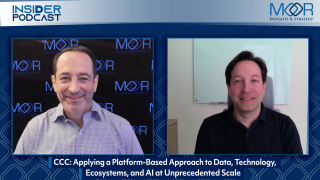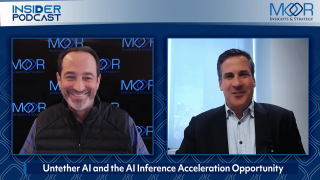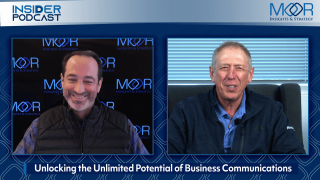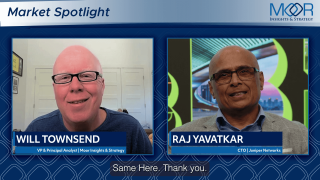On this episode of the Moor Insights & Strategy Insider Podcast, host Melody Brue is joined by Matthew Purdon, Sr. Product Director, Creative Cloud for Enterprise & SMB at Adobe during the Adobe Max conference. Their conversation focuses on Adobe’s response to the dramatically increasing need for content, particularly in terms of personalization, variety of channels, and velocity. Key points discussed:
- Content Demand Explosion: Adobe predicts a 5x increase in content demand in the next two years. This surge encompasses personalization, channel variety, and content velocity.
- Adobe Gen Studio’s Role: Adobe’s integrated end-to-end solution addresses challenges in the entire content supply chain and facilitates content creation by leveraging generative AI, enabling efficient collaboration between creatives and marketers.
- Content Supply Chain: The content supply chain process, from creative brief to content delivery, is inefficient in its current state in areas such as asset mismanagement and time wastage. Melody and Matthew explore how Adobe’s solutions enhance efficiency and speed to market.
- Macro vs. Agile Marketing: Adobe Gen Studio supports both macro marketing (large, brand-focused campaigns) and agile marketing (quick, iterative campaigns) by enabling the use of assets from macro campaigns in agile ones, improving efficiency and brand consistency.
- Control Over Content Creation: The importance of control in content creation is stressed, ensuring that AI tools like Firefly augment rather than replace human creativity and preserve brand integrity.
- C-Suite Attention on Content Velocity: The discussion shifts to why content velocity is a C-suite concern, emphasizing cost reduction and efficiency in content creation as key drivers.
- Adobe’s Competitive Edge: Adobe’s strength lies in its comprehensive product suite, seamless integrations, and data analytics capabilities, leading to a robust content management ecosystem.
- Ecosystem and Generative AI: Adobe’s ecosystem is tailored to unite marketers and creatives, facilitating content creation across professional and more accessible tools. Adobe is investing heavily in generative AI (like Firefly) to integrate into creative workflows, enhancing productivity and creative potential.
Overall, the conversation underscores Adobe’s strategic response to the increasing demands of content creation, focusing on efficiency, integration of advanced technologies like AI, and the balance of creative control with scalable content production. This is a great conversation you don’t want to miss!
Watch the full episode here:
Or listen here:
Disclaimer: This show is for information and entertainment purposes only. While we will discuss publicly traded companies on this show. The contents of this show should not be taken as investment advice.
TRANSCRIPT
Melody Brue: Hi, I’m Melody Brue with More Insights and Strategy and you’ve joined us for an Insider Edition podcast. I am here at Adobe Max, the creative conference, and I’m joined by Matthew Purdon, who is Adobe’s senior product director in Adobe’s digital media business unit leading Gen Studio solution. So Matthew, need for content has just exploded right now. Adobe says that in the next two years it’s going to go five X. So right now just the content, in terms of personalization and the number of channels and just all of the need and the velocity of content has just exploded. And you’re solving that with Gen Studio. Do you want to talk about that?
Matthew Purdon: Sure. Thank you very much for having me, Melody. So Adobe Gen Studios are integrated end-to-end solution to really solve problems that customers have with their entire content supply chain. We see the world becoming more and more hyper-personalized in types of experiences that consumers have, and when they have those kinds of experiences, to fuel those, you need both the data and the content. We need to identify who you are and then deliver the right content at the right time. If you’re not able to create all that content, you’re not going to be able to have those kinds of conversations with your customers. So what we’re doing is we are basically tying together end-to-end workflows across our products with the power of generative AI that allows it to be easier for creatives and marketers to collaborate together and create all of that content. That way they are able to actually do all of the campaigns that they would like to be able to do in order to reach those customers in those hyper-personalized experiences.
Melody Brue: So really addressing that velocity and scale. And so you talk about the content supply chain. Obviously people know what supply chain is, but really explain content supply chain and what that looks like for your customers.
Matthew Purdon: Yeah, sure. So if you think about a large campaign, you would start with a creative brief. The brief comes in from the marketers defining the segments that they’re going to speak to, the channels, the messaging, all of that. That gets then digested by the creative teams to create all of the content. And then as that content is being created, it goes through review and approval cycle with all the stakeholders and eventually delivered out to the channels. So along that entire chain of experiences that the creative markets are doing, collaborating and working together, there can be a lot of inefficiencies. Sometimes the assets are in different systems. There’s people at different locations globally. People may be uploading and downloading assets. The way people often handle this now is they may even just tracking it through an Excel spreadsheet. And what you lose, you lose out on the metadata. You have inefficient processes and a lot of wasted time and effort.
20 to 40% of a creative’s time can be lost, searching for assets, chasing after people, doing all kinds of activity that’s not the core creative work. So, one, we believe that in the content supply chain, you can gain greater efficiency across your teams. If you gain that efficiency, now you can create more content. So then you can actually have more content to deliver to more channels, more hyper-personalized experiences. And the faster it goes through, you can have faster speed to market as well, which is really important in terms of the faster and more iterative cycles that we’re seeing with consumers and customers and how they actually connect with a brand and the changes that are happening in real time often.
Melody Brue: I’ve heard this a couple of times here at Max, you’ve talked about the macro marketing and then the agile marketing. What is Gen Studio helping to solve in terms of how those two connect?
Matthew Purdon: Sure. So first, macro marketing is your large campaign. Think about your Super Bowl campaign or a big back to school campaign. Things where you’re spending a lot of money upfront, you’re thinking about it, you’re really creating a lot of strong branded assets. So that’s a macro campaign. An agile campaign, think of that as maybe some of your campaigns on social, maybe week to week promotional campaigns or maybe things that are happening in regions that are more… Or imagine that’s in regions that are further out from your actual core business. So those cycles are going to be a lot faster and iterative. They have maybe less investment sometimes as well as potentially less concern around the less eyes and attention on that content. But those agile campaigns often leverage a lot of the assets from those large macro campaigns. So the way we do this, if you can get your entire teams operating in one system, then all of that content that was created for those macro campaigns is available for those more agile marketing campaigns.
The way we are doing this with Gen Studio is, one, is think about having a repository that’s searchable so you can easily find all the assets and then templatizing those assets. We have Adobe Express for enterprise, which is connected to Adobe experience manager assets. So think about that you’re looking for an asset, you can find that asset and in one click you can open it up, have access to it in a template, make the changes, and then repurpose that asset. That can save time, it can save money. And the important thing with using things like templates is it allows that speed of marketing while you still have control of the brand. The creatives can lock down the key components.
The reason why people have not been able to do this as much is that they’re worried about unlocking all these creative things to people who may not have the skills and the technology. But now with the power of Firefly as well, you can have people create great content, you can do it on brand and have that go out much more faster without always having to go through the high cost of your core studio and agencies.
Melody Brue: That’s one thing I’ve noticed here at Max is the control has really been a core theme. Control for creatives to have more control over what they’re generating in terms of Firefly and all of the tools where it’s not just AI generating their work, it’s really them being able to put their creative work into it. And also control over brand and branding where if somebody opens something up in Express, it’s not going to ruin what they’ve done. They’re able to lock down the really core things where it’s like, don’t mess with that. And I think that’s really great. In terms of content velocity, this is something that basically the C-suite has really been paying attention to. And why is that? Where is this demand and importance coming from right now?
Matthew Purdon: Sure. I think a lot of it has to do with the costs. I mean, speaking to large enterprises, they could be spending anywhere from a hundred to $500 million just on content creation. That’s not even immediate placement. And think about where that cost is coming from. One is you’re eating up time because it’s inefficient, so things are taking longer. Another thing is people are recreating content because they don’t have access. They don’t know where that content is created. So if you’re looking to reduce cost, a 10 to 20% cost reduction on that becomes a significant amount of savings that can improve the bottom line of your company. We’ve been in a period where, through the high growth period, it was easy to cover over some of that because you’re like, well, we’ll spend a little bit because times are gray, we’re growing and you could digest that. Well, now we’re not, people aren’t growing budgets, they aren’t growing teams, so they need to… Yet the needs and the demand for the hyper-personalization is continuing.
So they now need to say, okay, I need to double, quadruple my output without increasing my costs. So now how do I gain those efficiencies? And that’s why it’s starting to become a conversation, the C-suite.
Melody Brue: Interesting. So when people are looking at that and they’re saying, well, now I need to quadruple, maybe even five X my output, why Adobe? I mean, I know you’re Adobe, so you’re going to tell me why Adobe, but really why?
Matthew Purdon: Well, the truth is this is an area we’ve cared about for a long time. We have an incredible suite of products that are utilized by many of the largest enterprises in the world, both on the marketing side and the creative side. And they’ve long talked to us in our relationship with customers, can you make this work better together? And so what we have been investing is in integrations between the products. So whether it’s the accessing AM assets through Workfront or in Express or the Workfront plugin that we have in Creative Cloud, all these things are streamlining the product experiences that removes a lot of the inefficiencies. But the other thing is we also have all this data analytics, whether you’re talking about Adobe Analytics and our real-time customer data profiles, think about that. So now we can actually start to track the content efficiency tied to actual creative decisions that are made way upstream and not just talking about a final asset, but actually the components, creative components such as headlines or images or texts that are part of that.
So I don’t think there’s anybody in the world who can basically connect not just the workflows, but the data with the impact. And you can then get to a true MROI around what your content’s doing, which will over time optimize and create better performance.
Melody Brue: And there’s probably not a creative in the world, I would assume, that doesn’t use at least one Adobe product.
Matthew Purdon: Probably, right? Probably at this point.
Melody Brue: That’s my guess.
Matthew Purdon: Most creatives use an Adobe product, but I think the other thing is with Adobe Express, what we’re also doing is we are basically empowering lots of people who may not have had the traditional skills to utilize some of our more pro tools to be able to have their imaginations come to life. And so we think that all human beings are creative and we want to power the tools and technology for everybody to realize their imagination. I would say that all people are creative and we’re finding more ways for everybody to unlock their creativity with what we offer.
Melody Brue: There certainly are a lot of creative people here, it’s pretty amazing. But let’s talk about that. How does Adobe’s ecosystem play into the content supply chain?
Matthew Purdon: Sure. Well, the ecosystem that we’ve created is to bring together the marketers and the creatives and power marketers on creating content. And so you can be using a Photoshop with one of our pro tools or Illustrator. You can create those as templates. Those templates can then be added to Express and accessed by these marketers to create content. And so we have an entire ecosystem there. The other thing is Firefly, right? Generative AI. We have one of the most powerful image models. We also just announced the release of our vectra model and our design model. And so we’re building out what we think is the largest suite of basically creative models for Generative AI that’ll be available in the world. And we’re building those into the actual workflows of the tool. So whether you’re a designer, an illustrator, a videographer, you can access those creative Generative AI tools as part of your workflow. It’s not separate, it’s just think about you’re doing it alongside because that’s where the human part comes in.
You have an idea, you take out some of the drudgery by creating it maybe a little faster and not doing some of the work. If you talk about what we do with generative fill and the ability to just highlight a small part of the image and just have something removed or added, that would’ve taken hours. That’s now part of the creative’s workflow. And then some of those same capabilities are made available in something like Express. And so the entire ecosystem of the way the Generative AI works with the pro tools and the more democratized tools like Express, the entire thing is integrated together as an ecosystem and then tied to assets so that those assets can then be easily accessed and modified even by marketers from within some of our marketing tools.
Melody Brue: And so with Generative AI, so Gen Studio, from what I’ve been told, is Gen was part of the naming because of Generative AI. You have a lot of plans for Generative AI across your whole portfolio. So tell me a little bit more about that. I mean, there’s probably some things you can’t tell me but let’s talk more about that.
Matthew Purdon: Sure. Well, I mean, first off, we want specific models as I’ve talked about for each of the different kinds of categories we have. So in image model, we have the vectra model. We’ve announced that we’re working on video and 3D models as well.
Melody Brue: That’s very exciting.
Matthew Purdon: But then we’re looking at how do we extend these models for brands? So brand control is so important. You don’t want people to go off and just create stuff that is totally off brand. So how do we empower within security and data privacy, our brands to then train models that are propriae to them that they can use and extend our model for their campaigns, for their brands. And so I think that that’s the other thing that we’ve just started working on with some of our customers, that we’re very excited about as well. And then other ways we can think about is how do we extend, not just the models themselves, but some of the workflows. So we’re integrating into our tools, but there could be some areas where some of these capability might be needed within a workflow that’s outside of our tools. Is there a way we can bring that into those workflows so that you can access it? And we want to just remove every single little sort of friction that’s in the process.
Melody Brue: I’d like to see it be able to tell me what tool I should use for whatever thing I’m needing. If I say, I’d like to create X and it says, go to this and use this.
Matthew Purdon: Oh, totally. Well, I mean you may not even need to go to the tool in the future because the way we see it is that, basically, we as human beings are conversation. If you think about we’ve had to teach ourselves how to use a computer, but maybe in the future the computer is more conversation with us. And so we describe what we want and it’s creating the things that we need in conversation with us where the needs of specific UIs may not be as needed in the same way for yourself.
Melody Brue: So you hinted at what’s next with some models for various things like video, but what should we be expecting? I mean, AI is changing so quickly and you guys have even changed so quickly. I mean, we now have seen Firefly two, which is a massive improvement even from not even a year ago from what we saw at Summit. What should we expect to see next time round?
Matthew Purdon: Well, I think we’re just getting started, all right. So you’ll see our family of models continue to expand. You’ll see new variations in the model, the model extensions I’ve talked about and these integrations. But then also in Adobe Gen Studio, you’ll see more integrations between our products as well. You’ll see more investment in the data behind it that drives it, whether it’s campaign data or asset data or performance data, how all that data matters because Generative AI also think about, there’s also stuff we’re doing around copy and text, not just imaging. And then AI as a tool itself, if once the system is connected, and one of the things we encourage our customers is by connecting these systems and investing now in the metadata that’s underpinning all of this, will allow AI to also start to understand your workflows, understand what’s happening, and develop new insights that create greater efficiency.
So by creating a system that all of your marketers and creatives are in, it’s creating that data that can be utilized and that’s what gets us really excited. But there’s some possibilities. We don’t even know what’s going to happen. But if everything’s disconnected and not there, your AI is only as good as the data that’s available to it. And so if it’s disconnected, you’re not going to get the visibility, you’re not going to be able to leverage what’s actually there that you’re creating all the time. Just get it into a system and then I think we’ll be wowing all of our customers with the insights that just might come up automatically. And maybe one day, I think that as we trust some of this and provide more guidelines and controls around it, some of the optimization might happen just right there on the edge where you’re getting new performances and creativity just by the systems working within the controls you put in place.
Melody Brue: Well, that’s amazing. I will look forward to next year. We can revisit this conversation.
Matthew Purdon: That’ll be a lot of fun.
Melody Brue: And we can see exactly where we are then. My guess is we’ll be even farther beyond where you think we could be by then.
Matthew Purdon: We might all be surprised. Thanks Melody.
Melody Brue: Well, thank you so much for joining us and this is, again, Melody Brue from More Insights and Strategy. And this is the Insider podcast and we are at Adobe Max, the Creative Conference. Thanks for joining us and if you like what you saw, please hit the subscribe button and we’ll see you at the next one.





















































































